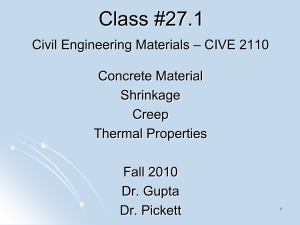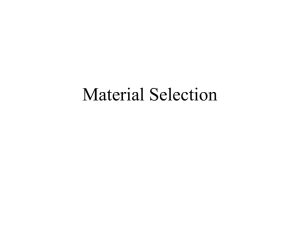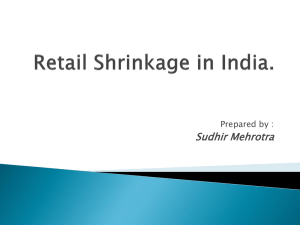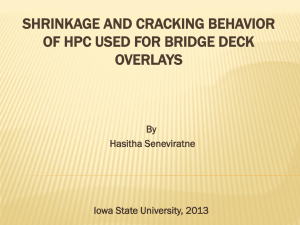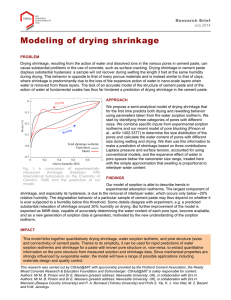hydrate 江苏省建筑科学研究院有限公司Jiangsu Research Institute of
advertisement
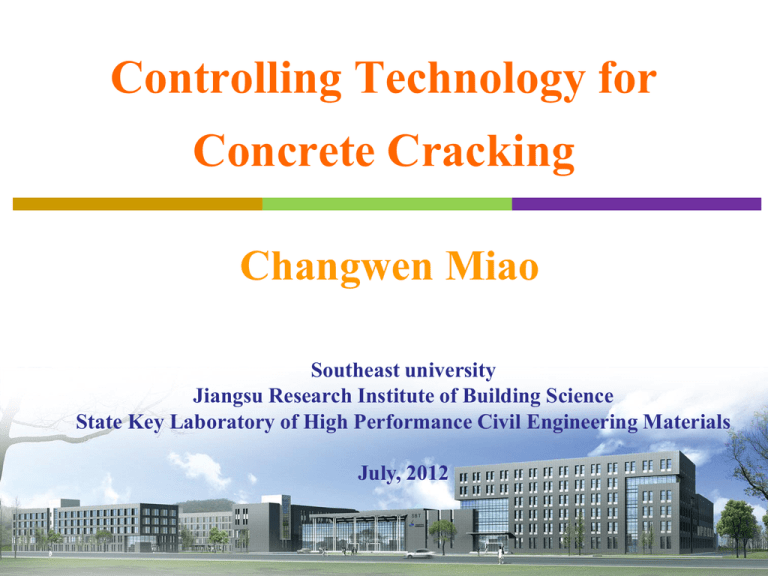
Controlling Technology for Concrete Cracking Changwen Miao Southeast university Jiangsu Research Institute of Building Science State Key Laboratory of High Performance Civil Engineering Materials July, 2012 Outlines Harmfulness of concrete cracking Main reasons for concrete cracking New technologies for concrete cracking controlling 江苏省建筑科学研究院有限公司 Jiangsu Research Institute of Building Science 2 Harmfulness of concrete cracking Cracking is still a common problem of concrete Concrete is the cornerstone for civil engineering, hydraulic and construction projects Concrete cracking is a common problem in civil construction projects Affect the use of safety ! Shorten the service life ! Huge economic loss ! 江苏省建筑科学研究院有限公司 Jiangsu Research Institute of Building Science 4 Concrete cracking declines structural capacity Changing the force condition of the concrete structure, leading to local and even the overall failure of buildings Weakening the stiffness of the concrete buildings with the dynamic changes of environment and loads Reducing the structural seismic capacity, threatening the overall stability and safety of concrete structures 江苏省建筑科学研究院有限公司 Jiangsu Research Institute of Building Science 5 Concrete cracking deteriorates structural durability Stage Ⅰ—Reducing the effective thickness of protective layer Stage Ⅱ—Accelerating the transmission of environmental aggressive media, air and moisture within the concrete structure Stage Ⅲ —Shortening activation and corrosion time of reinforcement, reducing the service life of concrete structures Stage Ⅰ Concrete cracking Stage Ⅱ Aggressive media, air, moisture intrusion 江苏省建筑科学研究院有限公司 Stage Ⅲ Reinforced steel bar initial corroding Reinforced steel bar volume expansion Jiangsu Research Institute of Building Science 6 Main reasons for concrete cracking 江苏省建筑科学研究院有限公司 Jiangsu Research Institute of Building Science 7 The causes of cracks Load-induced cracks ( structural cracks, about 5%-10%) Cracks induced by direct stress of external loads (static , dynamic load) , and Structural secondary stress Deformation-induced cracks ( non-structural cracks, 80% or more) Plastic shrinkage Self-desiccation shrinkage Drying shrinkage Temperature shrinkage Humidity changes Temperature changes Carbonation shrinkage Coupling ( deformation and load ) effect-induced cracks (5 % to 10% ) Cracks induced by alkali-aggregate reaction, freezing and thawing, uneven expansion, bad soundness and so on 江苏省建筑科学研究院有限公司 Jiangsu Research Institute of Building Science 8 Categories of concrete cracking Settlement cracks Shrinkage (drying shrinkage, autogenous shrinkage) cracks plastic cracks Shear cracks Temperature cracks Corrosion cracks 江苏省建筑科学研究院有限公司 Jiangsu Research Institute of Building Science 9 Shrinkage and cracking of concrete in plastic stage Capillary negative pressure The plastic phase can be divided into two stages Stage 1 Stage 2 No internal stress generated Internal pore negative pressure rising Time No shrinkage stress inside the paste (saturated), mainly in the forms of bleeding and plastic settlement 江苏省建筑科学研究院有限公司 Shrinkage stress (pore negative pressure) generated Mainly in the forms of horizontal plastic deformation and settlement Jiangsu Research Institute of Building Science 10 Shrinkage and cracking of concrete in plastic stage Settlement and bleeding crack bleeding Aggregate 钢筋 water Micro-crack formation caused by internal bleeding. Cracks formation due to constraint of subsidence by reinforcement. 江苏省建筑科学研究院有限公司 Jiangsu Research Institute of Building Science 11 Shrinkage and cracking of concrete in plastic stage Mechanics of plastic shrinkage and cracking 2 P cos r The shrinkage driving force is greater than the tensile strength between particles Bleeding rate≧Evaporation rate Bleeding rate < Evaporation rate 江苏省建筑科学研究院有限公司 Jiangsu Research Institute of Building Science 12 Shrinkage and cracking of concrete in plastic stage Drying shrinkage cracking—Evaluation methods 60 deformation /10-6 Ring method—double ring 40 outer ring 20 time/d 0 0 -20 2 4 6 8 10 inner ring -40 Can test out the expansion and shrinkage stresses Suitable for evaluation of expansive concrete (Patent Application No. : 201010100449.7 ) 江苏省建筑科学研究院有限公司 Jiangsu Research Institute of Building Science 13 Autogenous shrinkage of concrete Autogenous shrinkage-mechanics Root reason: the total volume decreases during cement hydration process (chemical shrinkage) . Autogenous shrinkage (Apparent volume decreases) Volume Cement Chemical shrinkage Pore + Water Hydration products Before hydration After hydration 江苏省建筑科学研究院有限公司 Chemical shrinkage is about: 6.4×10-2 mL/g; Autogenous shrinkage is one of the manifestations of chemical shrinkage, chemical shrinkage equals to the sum of autogenous shrinkage and pore volume formed Jiangsu Research Institute of Building Science 14 Autogenous shrinkage of concrete Autogenous shrinkage-mechanics 2 RT P cos ln( RH ) r M Direct reason: Initial state Before structure formation After structure formation After structure formation, further hydration cause to the meniscus generation inside the paste and the shrinkage stress 江苏省建筑科学研究院有限公司 Jiangsu Research Institute of Building Science 15 Autogenous shrinkage of concrete Autogenous shrinkage-testing methods Autogenous shrinkage (apparent volume decreases) Concrete Cement paste Corrugate pipe testing method 江苏省建筑科学研究院有限公司 Solving the defect that test ends of pipe debond with internal concrete in the vertical length measurement; Solving the interference of the probe to the early test results by using noncontact sensor technology; Realizing the staged and whole process testing since casting and molding, improving data reliability and continuity. Jiangsu Research Institute of Building Science 16 Autogenous shrinkage of concrete Autogenous shrinkage-testing methods Physical and mechanical characteristic parameters Early shrinkage driving force test since self-drying zero Pore negative pressure testing method time Application of semi permeable membrane characteristics of the water-saturated porous ceramic probe self-drying “time-zero” Realizing the characterization of initial structure formation and self- drying 0:00 Corresponding to the initial Solving the leak problem of traditional testing method, with structure formation; test range upgrading 1 times Corresponding to the starting Overcoming the international problem that traditional point of autogenous shrinkage method is difficult to test the shrinkage driving force in the humidity stage 江苏省建筑科学研究院有限公司 Jiangsu Research Institute of Building Science 17 Temperature deformation and cracking of concrete Temperature deformation—mechanics 1.Material inherent properties Temperature rising Causing expansion 2.Capillary pore stress relaxation Additional expansion 3.Liquid phase migration Delayed shrinkage (ignored usually) Thermal expansion deformation properties is significantly affected by humidity 江苏省建筑科学研究院有限公司 Jiangsu Research Institute of Building Science 18 Temperature deformation and cracking of concrete Temperature deformation and cracking Cracking reason-Thermal stress caused by temperature difference between inside and outside 90 thickness center temperature of the thickness / oC 85 Temperature distribution Adiabatic temperature rise 80 75 70 5m 65 4m 60 3m 55 50 2m 45 40 1m 35 30 25 0 5 10 15 20 25 30 Stress distribution Compression zone time/d Center temperature rise increases with the cross-sectional dimensions of the structure Tension zone Surface tension, internal compression 江苏省建筑科学研究院有限公司 Jiangsu Research Institute of Building Science 19 Temperature deformation and cracking of concrete Tempreature deformation cracking Crack criterion ℃ temperature T1 T2 Tl e% strain s stress Ta elel e3 e1pl e2pl t1 t2 t3 Cracking when tensile stress t caused by temperature deformation and creep is creep greater than the tensile strength of concrete e4 t time t Temperature Temperature rises stage decreases stage compression tension 江苏省建筑科学研究院有限公司 t Strength curve destroy Jiangsu Research Institute of Building Science 20 Temperature deformation and cracking of concrete Temperature deformation cracking-Evaluation method Temperature-stress testing machine Crack resistance parameters T Maximum temperature Tmax Temperature rising time, Stress occurring time, The first zero stress temperature TZ,1 The first zero stress temperature TZ,1 , Temperature peak occurring time, Maximum temperature Tmax , The second zero stress temperatureTZ,2 , s t Temperature Constant Rapidcracking temperature T c rises stage temperature cooling stage stage Cracking temperature Tc , Maximum compressive stress σc,max σc,max t Cracking stress sc Specimen stress (or center temperature) changes with age 江苏省建筑科学研究院有限公司 Jiangsu Research Institute of Building Science 21 Temperature deformation and cracking of concrete Temperature deformation cracking-Evaluation method Temperature-stress testing machine Elastic stress(Hooker Theorem) 12 Relaxation stress 8 4 0 strain(me) stress(MPa) Free-form deformation creep Constraint + creep (cumulative effect) Threshold Deformation strength Measured stress(after relaxation) 0 7 14 21 age (d) 28 recovery 0 0 age (d) Through controlling the total strain of the constrained specimen at 0, and combining with the reference specimen, functions describing parameters such as restraint stress, elastic modulus, creep coefficient and so on changing with time could be obtained. 江苏省建筑科学研究院有限公司 Jiangsu Research Institute of Building Science 22 Modern concrete cracking reasons are more complex Conventional concrete cement water fine aggregate coarse aggregate Optimizing ratio and processes Mineral admixture Chemical admixtures Modern concrete Composition characteristics Performance characteristics complex component large flowability low w/c ratio excellent mechanical properties more concent of cementitious materials good durability 江苏省建筑科学研究院有限公司 Jiangsu Research Institute of Building Science 23 Modern concrete cracking reasons are more complex Impact of cement composition and admixture on the cracking resistance cement composition and admixture Cracking temperature Fineness degree decreasing from 380m2/kg to Decreasing 9.5℃ 280m2/kg Alkali content decreasing from 0.95% to 0.55% Decreasing 7℃ C3A content reduced by 4% Decreasing 6℃ Mixed with 17% fly ash Decreasing 2℃ Mixed with slag or silica fume Increasing the cracking temperature The greater the reduction value of cracking temperature, the better the cracking resistance 江苏省建筑科学研究院有限公司 Jiangsu Research Institute of Building Science 24 Modern concrete cracking reasons are more complex Impact of superplasticizer Traditional naphthalene calcium lignosulfonate blank shrinking percentage (10-6) shrinking percentage (10-6) ( condensation polymer ) blank Time / d Time / d • Lower w/c and cement consumption, improving mobility ; • Increasing concrete shrinkage in the same w/c, dry shrinkage at 60d increased by 20%-40% 江苏省建筑科学研究院有限公司 Jiangsu Research Institute of Building Science 25 Modern concrete cracking reasons are more complex Autogenous shrinkage (10-6) Impact of W/C Time / d Compared to specimen with w/c 0.6: The autogenous shrinkage of specimens with w/c 0.5,0.45,0.4,0.35,0.3 and 0.25 at 1year increased by 175%, 250%, 275%, 335%,495% and 505%, respectively 江苏省建筑科学研究院有限公司 Jiangsu Research Institute of Building Science 26 Modern concrete cracking reasons are more complex The concrete strength grade is gradually increasing, while tension and compression ratio is gradually decreasing C30 concrete: Tension/compression, about 1/10-1/12 C50 concrete: Tension/compression, about 1/16 Brittleness increases, lead to a higher cracking risk 江苏省建筑科学研究院有限公司 Jiangsu Research Institute of Building Science 27 New technologies for concrete cracking controlling 江苏省建筑科学研究院有限公司 Jiangsu Research Institute of Building Science 28 General train of thought Inhibit water evaporation Cementitious materials hydration Hydration heat Autogenous shrinkage Plastic shrinkage Drying shrinkage Capillary negative pressure growth Environmental temperature Temperature changes water evaporation Shrinkage compensation by expansion Structure regulation and control Hydration heat regulation Temperature shrinkage crack resistance by fiber In-situ toughening Strength, toughness, creep Evaluation methodology Chemical shrinkage Force resistance Driving force Cracking resistance 江苏省建筑科学研究院有限公司 Jiangsu Research Institute of Building Science 29 Curing technologies in early age Initial setting, wiping the surface Plastic stage Hardening stage Hydration degree Monolayers with high evaporation resistance ability 江苏省建筑科学研究院有限公司 High performance curing materials with hydrophobic structure Jiangsu Research Institute of Building Science 30 Curing technologies in early age—water evaporation inhibition Mechanism air controllable structure with hydrophilic main chain and hydrophobic side chains Monolayers bleeding Inhibition evaporation by 75% water evaporation Water evaporation / g water Concrete Time / min Inhibition evaporation by 75% 江苏省建筑科学研究院有限公司 Jiangsu Research Institute of Building Science 31 Curing technologies in early age—New conservation materials Mechanism Water evaporation concrete Particle aggregation concrete Dense membrane with high evaporation resistance ability Membrane formation concrete 江苏省建筑科学研究院有限公司 concrete Jiangsu Research Institute of Building Science 32 Curing technologies in early age—water evaporation inhibition Mortar mix proportion 1 2 3 4 Reference Monolayers Monolayers can effectively suppress the plastic cracking risk 江苏省建筑科学研究院有限公司 Jiangsu Research Institute of Building Science 33 Curing technologies in early age—water evaporation inhibition Impact of monolayers on pore negative pressure Monolayers can effectively delay the appearing time of pore negative pressure inflection point of the surface mortar 江苏省建筑科学研究院有限公司 Jiangsu Research Institute of Building Science 34 Curing technologies in early age—water evaporation inhibition Impact of monolayers on plastic shrinkage The monolayers can reduce about half of the plastic shrinkage in the horizontal direction 江苏省建筑科学研究院有限公司 Jiangsu Research Institute of Building Science 35 Curing technologies in early age—water evaporation inhibition Engineering applications Dingxin Airport in Gansu Province ( the largest in Asia) Xigaze Airport in Thibet Suitable for terrible drying area, it could dissolve the problem of crack and crust on plastic concrete. 江苏省建筑科学研究院有限公司 Jiangsu Research Institute of Building Science 36 Curing technologies in early age—New conservation materials Effect crack Curing materials 80 (kPa) pressure Pore negative 孔隙负压 (kPa) No curing Curing materials Non-curing 60 40 20 0 0 1 2 3 4 时间 Time (h) /h Delaying the time when capillary negative pressure begin to increase and reduce crack risk. 江苏省建筑科学研究院有限公司 Jiangsu Research Institute of Building Science 37 Curing technologies in early age—New conservation materials The second double of the Lanxin Railway Taizhou bridge across yangzi river Suitable for drying and high temperature condition, it could dissolve the problem of drying crack of hardening concrete at early stage. 江苏省建筑科学研究院有限公司 Jiangsu Research Institute of Building Science 38 Chemical techniques for shrinkage-reducing General ideas Water P Effect of the reduction of surface tension on additional pressure on the curved surface Water Schematic diagram of evaporation of capillary moisture 江苏省建筑科学研究院有限公司 2s r The surface area of the surface tension in the pore solution was significantly reduced, which can effectively reduce autogenous shrinkage and drying shrinkage of concrete. Jiangsu Research Institute of Building Science 39 Chemical techniques for shrinkage-reducing Traditional low molecular shrinkage reducing agent The effect of SRA on Mechanical Properties of Concrete (same amout of water) Shrinkage reduction rate(%) 60 50 0.5% 1.0% 1.5% 2.0% 40 gas content slump /% /cm 30 content /% 20 0 12.0 10 0.5 0 0 20 40 60 80 100 Age(d) The effect of SRA with different dosages compressive strength/MPa 3d 28d 2.7 28.5 45.1 13.0 1.8 26.3 44.5 1.0 15.0 2.0 24.3 42.3 2.0 18.5 1.9 22.4 39.8 Reduced shrinkage contradiction Reduced strength The structure-activity relationship study found that the traditional low molecular shrinkage reducing agent can not fundamentally solve the problem of declining strength of concrete. 江苏省建筑科学研究院有限公司 Jiangsu Research Institute of Building Science 40 Chemical techniques for shrinkage-reducing High dispersed comb copolymer shrinkage reducing agent The molecular tailoring technology was adopted to make the alkyl polyether with shrinkage reducing function and steric effect graft to the main chain of copolymer, then the structure-activity relationship between molecular structure and shrinkage performance of the grafted copolymer/cement/water composite system was studied, as a result, a new type amphiphilic and high dispersion comb copolymer class concrete shrinkage reducing agent has been invented, which realized the unity of shrinkage reducing and water reducing and dispersion. Short side chain (shrinkage reducing group)-shrinkage reducing, dispersion Side chain Long side chain Long polyether side chain – steric effect Adsorption behavior regulation - dispersion 江苏省建筑科学研究院有限公司 Jiangsu Research Institute of Building Science 41 Chemical techniques for shrinkage-reducing High dispersed comb copolymer shrinkage reducing agent -6 1000 FDN FDN+2%SRA SRPCA 800 600 400 200 0 Self-desiccation shrinkage (×10 ) 1200 -6 Settlement shrinkage (×10 ) Impact on shrinkage at early ages 0 1 2 3 4 5 6 Time, t/h (30min after mixing) 7 8 300 250 FDN FDN+SRA SRPCA 200 150 100 50 0 0 5 10 15 20 25 Time, t/h (from initial setting) (a) condensed shrinkage (b) autogenous shrinkage before 1d 43% lower than the naphthalene series 53% lower than the naphthalene series 江苏省建筑科学研究院有限公司 Jiangsu Research Institute of Building Science 42 Chemical techniques for shrinkage-reducing High dispersed comb copolymer shrinkage reducing agent -6 500 -6 Drying shrinkage/(×10 ) Autogenous shrinkage/(×10 ) Impact on shrinkage in the mid- or late period FDN 400 SRPCA 300 200 FDN+SRA 100 0 0 10 20 30 40 50 60 70 80 90 100 Age/d FDN 160 140 120 100 SRPCA 80 60 FDN+SRA 40 20 0 -20 0 10 20 30 40 50 60 70 80 90 100 Age/d (a) drying shrinkage (b) autogenous shrinkage 42% lower than the naphthalene series at 28d 江苏省建筑科学研究院有限公司 180 53% lower than the naphthalene series at 28d Jiangsu Research Institute of Building Science 43 Chemical techniques for shrinkage-reducing High dispersed comb copolymer shrinkage reducing agent Impact on plastic cracking Tablet plastic cracking experimental results Admixtures Crack time/min Maximum crack width /mm Crack area/mm2 SRPCA 380 0.27 100.15 FDN 190 1.0 763.32 FDN+2%SRA 280 0.6 293.05 The cracking area is 13% of that of naphthalene series, with crack width only 0.27mm. 江苏省建筑科学研究院有限公司 Jiangsu Research Institute of Building Science 44 Chemical techniques for shrinkage-reducing High dispersed comb copolymer shrinkage reducing agent Impact on shrinkage in the mid- or late period The ring cracking test results Admixture Age of first racking Tc/d Crack width Wd SRPCA 6.5 0d 0.397 1d 0.535 3d 0.744 7d 0.936 14 d 1.093 28 d 1.134 FDN 4.5 0.989 1.261 1.75 1.824 2.022 2.033 FDN+2%SRA 7.0 0.693 0.767 0.846 0.933 1.106 1.155 Crack width reduced more than 45% compared with the naphthalene series Realizing a unified effect of water reducing and shrinkage reducing at a lower dosage, effectively reducing the plastic shrinkage, early and late autogenous shrinkage and drying shrinkage . 江苏省建筑科学研究院有限公司 Jiangsu Research Institute of Building Science 45 Chemical techniques for shrinkage-reducing Shrinkage-reducing type polycarboxylate superplasticizer Lower content, _ _ _ _ _ Side chain (SRA) shrinkage reducing dispersion -6 300 250 FDN FDN+SRA SRPCA 200 150 100 50 53% lower than the naphthalene 0 0 5 10 15 20 25 Time, t/h (from initial setting) dispersion and 180 FDN 160 140 120 100 SRPCA 80 60 FDN+SRA 40 20 53% lower than the naphthalene after 28 days 0 -20 0 10 20 30 40 50 60 70 80 90 100 Age/d (a) Autogenous shrinkage before 1st day 江苏省建筑科学研究院有限公司 between reduced shrinkage Autogenous shrinkage/(×10 ) -6 Self-desiccation shrinkage (×10 ) Long side chain unified function (b) Autogenous shrinkage Jiangsu Research Institute of Building Science 46 Chemical reduction techniques Engineering Applications of shrinkagereducing type polycarboxylate superplasticizer applications Model road tunnel Shrinkage deformation and the maximum temperature rise are controlled within a reasonable range The main structures were not cracked and leaking Suzhou Dushu Lake Tunnel Gongboxia Hydropower Station Applications of shrinkage reducing admixtures(SRA) CFRD concrete , the effects of reduced cracking is significant Wuxi Lihu Tunnel 江苏省建筑科学研究院有限公司 Jiangsu Research Institute of Building Science 47 Shrinkage-compensating technology by expansion Composition characteristics:low W/B,low porosity Shrinkage cracking characteristics: shrinkage caused by autogenous, dry and thermal factor Characteristics of the environment: temperature and humidity history Mutiple complex between Ca and Mg CaO by light burning MgO with high activity MgO with high activity 江苏省建筑科学研究院有限公司 Stable hydration products Small water requirement Early expansion Medium-term expansion Improve concrete anti-cracking capacity Controlled and regulated expansive history Large expansive performance, low dehydration shrinkage Compensating autogenous and thermal shrinkage , and reducing dry shrinkage Thought Later expansion Jiangsu Research Institute of Building Science 48 Shrinkage-compensating technology by expansion Deformation performance 300 200 100 0 0 10 20 Time/d Time/d 0 0 30 Deformation/10 -6 -100 -200 -300 -400 -500 C30 Reference C30 SBTJM-MC C50 Reference C50 SBTJM-MC 60 30 40 -6 Water curing Deformation/10 deformation/10 -6 400 Waterproof curing 200 C30 Reference C30 SBTJM-MC C50 Reference C50 SBTJM-MC 100 Time/d 0 0 30 60 90 120 -100 -200 -300 C30 Reference C30 SBTJM-MC C50 Referrence C50 SBTJM-MC Expansion rate can be controlled Autogenous shrinkage can be inhibit 90 120 effectively Dry curing Dry shrinkage can be significantly reduced so that stable period can be in advance. In the standard dry condition without curing, dry shrinkage rate for C50 with the content of 8% was only 45% of the reference concrete after 120 days. 江苏省建筑科学研究院有限公司 Jiangsu Research Institute of Building Science Shrinkage-compensating technology by expansion Crack resistance performance---Ring method Cracking time and initial crack width Cracking time Initial crack width/mm C30 reference 4d 21h 0.1 C30 with expansive agent 11d 3h 0.05 C50 reference 4d 18h 0.03 C50 with expansive agent 7d 16h 0.01 C30 (a)reference (b)with expansive agent 江苏省建筑科学研究院有限公司 C50(a)reference (b)with expansive agent Jiangsu Research Institute of Building Science Shrinkage-compensating technology by expansion Crack resistance performance ---Improved ring method 16 10 Reference 0 0 2 4 6 8 10 12 14 16 -5 -10 inner ring -15 deformation/10 deformation/10-6 -6 outer ring time/d 5 Expansive agent 12 outer ring 8 4 time/d 0 0 4 8 12 16 -4 inner ring -8 -20 1.2 reference 0.8 stress/MPa Crack resistance performance of concrete(drying shrinkage of double ring) development rate of the average 0.4 0.0 0 -0.4 -0.8 Cracking time time/d 4 8 12 Cracking risk (MPa/d) 16 reference 14<T C mixed with expansive agent Expansive 14<T C agent 江苏省建筑科学研究院有限公司 stress 0.2>q>0.1 low 0.1>q Very low Jiangsu Research Institute of Building Science Shrinkage-compensating technology by expansion Crack resistance performance—TSTM(C30) Key testing parameters comparison Unit Expansive agent Non expansive agent MPa 0.78 0.29 h 49.3 37.9 Maximum expansion values( constraint) ×10-6 37.6 36.3 Maximum expansion values(free) ×10-6 220 148 h 57.2 46.2 Maximum temperature ℃ 38.2 35.5 Maximum temperature rise ℃ 29.4 27.0 The second zero stress temperature ℃ 34.9 35.5 The second zero stress time h 109.0 70.9 Stress at room temperature(20℃) MPa 0.22 0.15 Cracking stress MPa >3.1 2.0 92.9% 92.5% Parameter Maximum compressive stress Time corresponding to maximum compressive stress characteristic parameters of temperature-stress test Time corresponding expansion values to Maximum Stress reserves Comprehensive evaluation index Cracking time h >164.4 148.4 Cracking temperature ℃ <-18.2 -7.9 江苏省建筑科学研究院有限公司 Jiangsu Research Institute of Building Science Shrinkage-compensating technology by expansion Engineering applications 180 500 Autogenous volume-6 自生体积变形(×-610 deformation(10 ) ) 160 settlement shrinkage/10 plastic shrinkage/10 -6 -6 140 400 120 100 300 200 100 60 40 20 0 0 0 -100 80 5 10 15 20 25 Age/h Deformation in early age 0 4 8 12 16 龄期(d) Age/d 20 24 28 Deformation in later age Compensating concrete autogenous shrinkage on phased as well as whole process Falls Hydropower Station in Sichuan Typical engineering North Square of Nanjing South Station of Beijing-Shanghai high-speed railway Olympic Sports Center in Xuzhou Samsung sewage treatment plant in Suzhou Industrial Park Phase II project of Nanjing Lukou International Airport Zhenjiang Exit Underground Engineering Media Center Building in Changzhou 江苏省建筑科学研究院有限公司 Jiangsu Research Institute of Building Science 53 Controlling technology of heat hydration hydrated heat release rate Thinking Rapid reaction period Acceleration and Induction period deceleration period Stabilized reaction period hydrate Time/h Concrete temperature rising mainly due to: Rapid hydration and concentrated exothermic of C3A and C3S phases 江苏省建筑科学研究院有限公司 Jiangsu Research Institute of Building Science 54 Controlling technology of heat hydration Thinking Water structure Multi-hydroxy or polyhydroxycontaining structure + CaCl2 PAA-g-MPEGNa [a] [b] Adsorption and calcium chelation of hydroxyl in additive agent molecules Inhibition of Ca(OH)2 crystallization Regulation of condensation process and hydrated heat release rate 4 放热速率(mw/g) release rate(mw/g) hydrated heat Reduce the hydration rate of C3A and C3S phase 3 Reference 2 1 0 0 2 4 6 8 Time/d 时间(d) 10 江苏省建筑科学研究院有限公司 12 Jiangsu Research Institute of Building Science 55 Controlling technology of heat hydration Water structure Admixtures with special molecular structure 15 CaCl2 100%Cement 12 -1 Hydration heat rate/(J(g.s) ) Peak value was reduced by 60% + PAA-g-MPEGNa [a] Controlling the process of cement hydration 9 100%Cement+FDN 6 100%Cement+PCA 70%Cement+30%Fly ash+PCA 3 0 0 24 48 72 江苏省建筑科学研究院有限公司 120 144 168 / (J/g) 250 heat of hytration Improve capabilities of temperature control of Mass concrete 96 Time/h 300 Controlling heat release of cement hydration [b] 200 150 100%Cement 100 100%Cement+FDN 100%Cement+PCA 50 70%Cement+ 30%Fly ash+PCA 0 0 24 48 72 96 120 144 168 168 Time(h) Jiangsu Research Institute of Building Science 56 Controlling technology of Heat hydration No cracks in about 600m3 mass concrete in the thirdphase project of Three Gorges. Three Gorges Project Prather onzalez dam in Sudan High friction Zam Hydroelectric in Pakistan Jinping Hydropower Station 江苏省建筑科学研究院有限公司 Jiangsu Research Institute of Building Science 57 In-situ toughening technology Mechanism--chemical bonding ] ] [ [ Cement-based materials Silylated cement particles m m Covalent bond Cement-based materials Chemical bond formation 江苏省建筑科学研究院有限公司 Structure of organicinorganic hybrid Jiangsu Research Institute of Building Science 58 In-situ toughening technology Concrete performance —Fracture energy 2.5 7d fracture energy 2.0 PH max KIC W1 W2 GF (7d) (KN) (MPa· 𝐦) (N·m) (N·m) (N·m-1) blank 3.26 0.81 0.578 0.242 96 1 3.96 0.98 1.137 0.398 179 2 3.82 0.94 1.212 0.615 213 7d Reference Content 1% Content 0.5% 1.5 P/kN 编号 No. 1.0 0.5 0.0 0.0 0.1 0.2 0.3 0.4 0.5 0.6 0.7 0.8 0.9 1.0 1.1 1.2 1.3 1.4 1.5 CMOD/mm 3.0 28d fracture energy 2.5 编号 No. PH max KIC W1 W2 GF (28d) (KN) (MPa· 𝐦) (N·m) (N·m) (N·m-1) blank 4.04 1.00 0.709 0.27 115 1.0 1 4.70 1.16 1.49 0.48 231 0.5 2 5.22 1.29 1.13 0.69 213 0.0 28d Reference Content 1% Content 0.5% P/kN 2.0 1.5 -0.1 0.0 0.1 0.2 0.3 0.4 0.5 0.6 0.7 0.8 0.9 1.0 1.1 1.2 CMOD/mm 江苏省建筑科学研究院有限公司 Jiangsu Research Institute of Building Science 59 In-situ toughening technology Project—Taizhou brigde(Box girder—small thickness, Low volume-surface area ratio) Good dispersion,w/b up to 0.33,Good fluidity retention capacity No cracks occurred reference toughening material 江苏省建筑科学研究院有限公司 Jiangsu Research Institute of Building Science 60 Conclusions To control the concrete cracking is entirely possible as long as appropriate measures are used. Evaporation reducing and water-retention materials can reduce water evaporation by up to 75%, which can improve the concrete crack resistance significantly in early age. Unlike traditional polycondensation type superplasticizer, the new generation graft copolymer can realize molecular design and graft appropriate functional groups to achieve the unity of water reduction and shrinkage reduction. Admixtures can control hydration exothermic process, improving temperature control capabilities of mass concrete. 江苏省建筑科学研究院有限公司 Jiangsu Research Institute of Building Science 61 Conclusions Multiple compound expanding agents of calcium oxide and magnesium oxide, can play the expansion roles of active calcium oxide and light burned magnesia in different periods, to compensate for concrete shrinkage in the whole process, and to enhance the crack resistance. As the compressive strength is increased and tensile and compressive strength ratio is decreased, in-situ toughening technology can be used to enhance the fracture energy and reduce the cracking risk of concrete. 江苏省建筑科学研究院有限公司 Jiangsu Research Institute of Building Science 62 Thank you!

